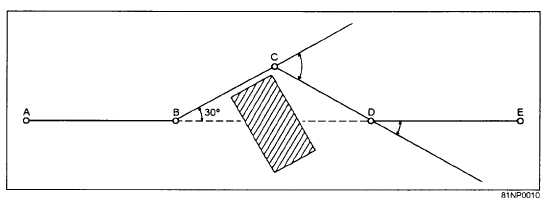Figure 10F
IN ANSWERING QUESTIONS 10-43 THROUGH
10-46, REFER TO FIGURE 10F.
YOU ARE
RUNNING THE LINE AE AND THE POWERHOUSE IS
IN YOUR WAY.
WHILE AT SETUP B, YOU
Discovered THAT A 30-DEGREE DEFLECTION
ANGLE WILL CLEAR THE OBSTACLE.
YOU
DECIDED TO USE THIS ANGLE TO BYPASS THE
POWERHOUSE.
10-43.
What is your next step after
recording the deflection angle
at B?
1.
Take a backsight at A and
measure angle ABC
2.
Move the instrument to D and
measure the deflection angle
at D
3.
Move the instrument to C and
measure the deflection angle
at C
4.
Move the instrument to A and
measure angle BAC
10-44.
If you use the angle offset method
of bypassing an obstacle, what is
the size of the deflection angle
at C?
1.
30°
2.
45°
3.
60°
4.
75°
10-45.
Which of the following distances
is equal to CD?
1. AB
2. BD
3. DE
4. BC
10-46.
What is the deflection angle at
point D?
1.
30°L
2.
30°R
3.
60°L
4.
60°R
10-47.
The angle offset and the
perpendicular offset methods are
useful in establishing a survey
line under which of the following
conditions?
1.
2.
3.
4.
When the length of the survey
line cannot be determined by
chaining
When the slope becomes great
enough to require breaking
chain
When the line of sight on the
chosen survey line is
obstructed
When the backsiqht distance is
much less than the foresight
distance
10-48.
The “balancing in” process should
be used to locate an intermediate
point between two control points
on a survey line under which of
the following conditions?
1.
2.
3.
4.
When the distances from the
intermediate point to the
control points are
approximately equal
When neither control point is
visible from the other, and
the other methods of bypassing
an obstacle cannot be used
When the intermediate point is
much closer to one of the
control points than it is to
the other
When the instrument adjustment
has a known error
71

